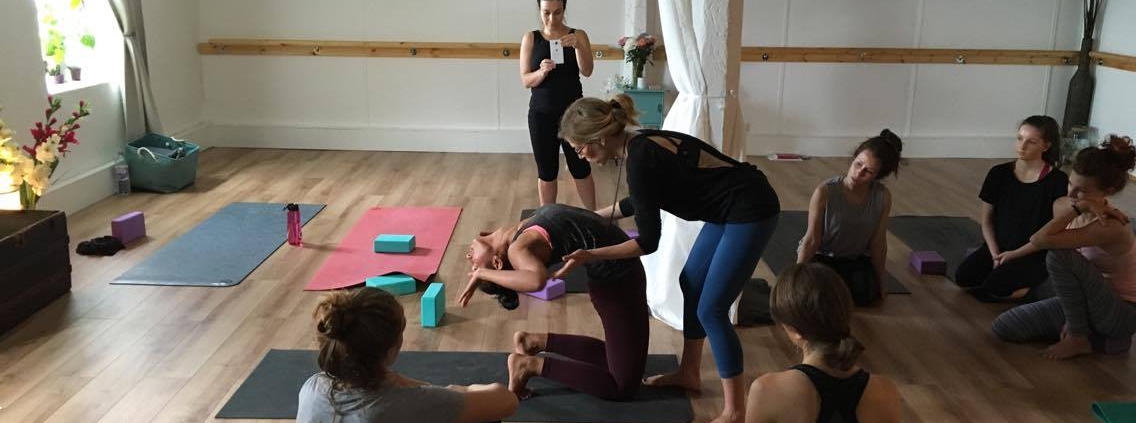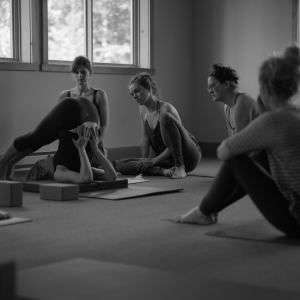The Value of Studentship
Last year I moved away from the small community where I had been living for nine years, and one of the reasons I did was that I was missing being part of a larger yoga community. This last year of living in Whistler has been wonderful as I have been able to be a student in many more teachers classes which has been a real treat after so many years of primarily doing home practice. As I am now going to more studios and classes than I had been for a while I am also able to notice how yoga practice has changed in the last decade. Much of the changes are inspiring, such as how many more people are practicing yoga, from all walks of life and with many different intentions for practice. I think that overall this is a good thing as yoga is powerful medicine and I am glad more people are able to access it. But as we have worked to make yoga more accessible I also believe we have lost a few things, and the emphasis on good studentship is one of them. Perhaps this is because there has been more of a shift towards seeing students as customers as studios get larger, and we are afraid to lose them if we “tell them what to do”? or maybe we have simply forgotten the value that is encoded within the seemingly straightforward teachings on etiquette and studentship that we received from our own teachers?
I feel very fortunate that when I began my journey as a yoga student my teachers were quite traditional and laid out clear guidelines for me on how I was expected to act in a class, in the shared space of the studio, and in relationship to my personal practice. These teachings were given to me in order to maximize my ability to learn, as well as to support the learning environment for others, and if hadn’t receive them early on I may not be the student and teacher I am today. Often when I am teaching or practicing in larger studios these days I am saddened to see that other students have not been so fortunate and as a result are getting less out of their investment in their practice. And I believe this also has an effect on how yoga is being taught overall. The lack of good studentship perhaps allows many yoga teachers to show up with less intention and to give less to their students (because they are not really listening anyway, so who cares what I say?). This makes me incredibly sad. I think we need to remember that there is an exchange of energy that happens in the classroom and it is vital to growth for both teachers and students and it is rooted in good studentship. Good studentship benefits everyone in the yoga community and the discipline we gain from it can strengthen the quality of integrity we bring to everything else we do. When my teachers taught me how to be a good student they were teaching me how to become a more disciplined, responsible, and respectful person, and aren’t those some of the primary virtues we are striving for on this path? I believe that being a good yoga student will also allow you to learn more and receive more value from the time and money you put into your practice. It will support the learning environment in the place where you practice, and elevate the level of practice in your community. It will lay a foundation for a lifetime of practice that can grow and evolve as you do and at its best it will challenge, and encourage your teachers to show up in a professional manner and deliver the best classes they can possibly teach.
Tools for Strengthening Studentship
Below I have listed some of the key teachings that I have received from my teachers on studentship. These teachings have supported me in my practice over the last fourteen years, allowed me to get the most out of any class I go to, and empowered me in receiving wisdom from many different teachers within a variety of traditions. I’ve grouped them in to three main categories- Take Responsibility, Be Respectful, and Cultivate Discipline.
1. Take Responsibility
Pick A Class That Is Suitable To Your Needs: So often I see students showing up to classes based on the time, rather then their needs. This can lead to frustration on both the student’s part, and the teachers, as we are not able to provide the experience that the student wanted or needed. Take the time to read class descriptions and levels carefully. Consider why you are going to class and what you most want to receive, and then pick a class that will offer you that. If you are unsure which class is best than ask. Please understand that not all yoga is the same and styles can differ wildly from Hot, to Power, to Restorative and all have different intentions, limitations, and benefits. And finally be honest about your current physical condition and choose a class that will be appropriate for you.
Be Honest About Injuries And Physical Limitations: A group movement class is not always the safest place for students who are nursing recent injuries or have chronic pain. Out of respect for your condition, and the teacher, please let us know ahead of time if you are injured and will be modifying your poses. Most teachers will do their best to offer modifications within the practice but it is not always easy when the classes are large and the range of students levels is hugely varied as they often are these days- in these cases you may not get the support you need to adjust for your injuries so see point number one above and pick a class that is suitable to your needs so that the teachers can help you better. And please do not assume that your injury doesn’t matter, and that the teacher should not worry about you. It is our job to worry about you, and everyone else in the class, and it causes much more disruption when we find out about an injury while already in the flow of the class whereas even just a few minutes of warning before class can help us to adjust what or how we are teaching in order to support those with injuries in the room.
Ask Questions: Asking questions is incredibly valuable and if something is unclear, such as class descriptions and levels, please ask the teacher for more clarification so that you can make informed decisions. If you are in pain while doing a pose and are not sure what do to please ask for support and if you want to learn more about something in regards to your practice than speak to your teachers- I personally love it when my students show interest in their practice and it encourages me to learn more! If you don’t understand something that is said in class then ask, if not during class then certainly after, so much learning happens in these conversations- for both the teacher and the student.
2. Be Respectful
Do What is Being Taught & Move With The Class: Just because you have an advanced practice doesn’t mean you should always do the most advanced variation of the pose being taught! If you have a good teacher they have a reason behind their sequencing and are teaching a pose in a certain way for a reason. I think it is very important to respect that, as doing your own thing in yoga class is disrespectful to the teacher and more importantly to the learning environment as it can confuse newer students and those who are there to learn. If you want to do your own practice do it at home, or try to get a few minutes before and after class to bust out your handstands, but remember that a big part of what makes a class great is when everyone is moving together as a group. When you rush ahead, anticipate what the teacher is going to say, or do your own variations you are disrupting that potent group energy. If you really think the teacher is a fool and the class in too unbearably slow for you then please just be a good student and finish the class with respect, and then don’t come back again. It’s as simple as that, but remember your manners when in the class. And to all you yoga teachers out there, I hate to say this but you are some of the worst offenders. Just because you did a teacher-training program does not make you an expert. When you are in another teacher’s class be a respectful student and remember that other students see you and notice. A respectful student is more likely to be a respected teacher!
If You Need To Leave Early Tell The Teacher: Sometimes timing doesn’t work and we may have to leave a class a bit early. I get that, and I appreciate it when teachers allow me to take part in class even though I need to slip out a few minutes early. But if you can’t stay for the whole class then alert the teacher ahead of time. When you walk out of a class without saying anything the teacher doesn’t know if you are hurt, upset, or just have to go- this is hugely distracting and can be dangerous if a student is actually feeling ill and needs attention. And finally if you are going to leave early please position yourself in class so that you can slip out quietly without much disruption to other students.
Be Open To Learning Something New: When you go to a new teachers class please enter with an open mind and remember that there are many approaches to yoga philosophy and practice- you don’t have to agree with them all, but please be open. If a teacher teaches a pose in a way you have not learned before don’t assume it’s wrong just because it’s different. Give it a try and if it doesn’t make sense definitely ask what the teachers reasoning is- if they are a good teacher they have a good reason for doing it the way they do- and again you don’t have to agree with it, but if it won’t hurt you at least be willing to try it, you may learn something new! And if you come to a class that is a different style than what you usually do please respect that lineage. When I go into the Mysore room of an Ashtanga studio I do the practice as outlined in that lineage, and if I am in an Iyengar class I do it the way it is done there. That is simply respectful and it has allowed me to learn and understand different approaches. If you don’t like the approach don’t come back, but when you are in Rome please do as the Romans do.
3. Cultivate Discipline
Commit to Practice, & Be Patient: I believe that one of the greatest obstacles to growth, and one of the leading causes of injury in yoga classes can be attributed to a lack of commitment to practice. I try to make it very clear when I am teaching that some of the things that I can now do may look easy but they are not, and most of them took me years of dedicated practice to perform. In this modern age of instant downloads this is a very important thing to remember. Nobody expects you to be able to do an advanced pose the first time you learn it, and you shouldn’t expect that of yourself. The path of learning takes years and subtlety, awareness and understanding will all increase over time. There are no shortcuts. This quality of dedication and patience will keep you safe and mindful in the classroom and will support you in your life off of your mat as well.
Learn How to Listen: We are losing our ability to listen in this visually oriented modern world. This makes learning yoga very difficult, as it is still primarily an oral tradition, and at the most basic level we will need the ability to hear a verbal instruction and to then be able to translate that into a physical action in an asana class. Learning how to listen starts the moment the teachers comes into the room. Sit up, be attentive, stay focused, slow down, and listen to what is being said. This is hard when most of us seem to be suffering from increased levels of attention deficit disorder as life moves faster and information is parsed out in increasingly shorter sound bites, but it is vital. Real life moves at a much slower pace and in order to be present for it we must re-claim our ability to listen deeply. Your yoga class is a great place to practice this!
Show up Fully: Showing up fully does not mean to go big in every single class, it means to quietly and without any expectation, simply show up again and again. The discipline that you cultivate when you show up for your practice, day in and day out, will strengthen the quality of intention you bring to everything else you do. This means to commit to practice on the days you feel good, and the days you don’t. It means to show up with attention for your favourite teachers class, and for their sub when they are away. It means to be willing to modify your practice when you are injured or exhausted and to do that without any sense of attachment. This is probably the most valuable lesson of studentship I learned from my teachers, and I learned it from their living example. Yoga teachers remember this as it is the most important gift you can share with your students, show them the value of showing up over the long haul and inspire them to do the same.
Final Thoughts….
There is so much more that could be said about studentship, but this has already been a very long post so I will leave it there for now. I hope that you find this helpful and would love to hear anything you would like to share on this topic as I think it is worthy of discussion. I hope that we can keep yoga accessible but bring back some of the discipline that has been lost so that more people can receive the true depth and power that the practices can offer. Thank you as always for reading. Blessings to you on your path, may your flourish and evolve through your dedication to mindful sadhana.















